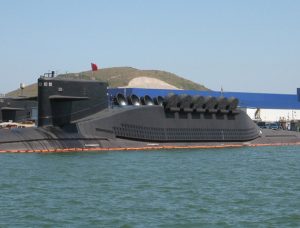In August a Chinese research vessel conducting underwater surveys in the Caroline Islands was regularly watched by U.S. surveillance planes. Some of the expedition’s scientific discoveries were reported in Chinese media, but the U.S. military’s interest came to light in interviews the lead researcher gave the South China Morning Post last week. The surveys are the latest in a pattern of Chinese hydrographic research in strategic waters critical for submarine operations beyond the first island chain.
The Carolines, located about 300 to 400 miles southeast of Guam and the Marianas islands – home to major U.S. air force and submarine bases – have expansive underwater trenches and mountain ranges. The Chinese researcher, Xu Kuidong, said that the expedition’s findings would be shared with the Chinese military. SCMP explained that the area’s underwater geography can create unexpected turbulence that can threaten submarines, implying that the expedition had direct military application.
While it claims to have found rare coral formations, which were also reported in Chinese media, Xu also made the expedition’s military objectives clear, saying “it is all about the Second Island Chain” and “here are many efforts going on to breach the Second Island Chain, this is part of them.”
Accurate hydrographic information of the Carolines is critical for Chinese submarines to operate there safely. In 2005, a navigation and charting error caused a U.S. submarine to crash into an underwater seamount in the area, killing one sailor. Guam is a critical base and logistics hub for the U.S. military in the Pacific. Chinese submarines could threaten the flow of forces and supplies from Hawaii or the U.S. mainland to Guam and on to the Philippines or South China Sea.
Last year it was learned that China conducted surveys of critical waters near Benham Rise east of the Philippines. Those surveys could enable Chinese submarines to cut off major access routes to the South China Sea from the Western Pacific.
In addition to enabling Chinese submarines to operate in the Carolines or off the Philippines, the surveys are also crucial to Chinese efforts to try and find other countries’ submarines operating there. Photographs revealed this summer show that China appears to be building specialized submarine-detection and tracking ships similar to U.S. SURTASS vessels that regularly operate in the Western Pacific and have been favorite targets of Chinese harassment, most spectacularly in the 2009 Impeccable incident. These new Chinese ships would need detailed hydrographic information to effectively search for submarines in the complex underwater geography off the Philippines or Carolines.
This explains why the United States would want to keep tabs on China’s research in the area.
Of the U.S. surveillance, Xu said that they were in international waters and the U.S. has “no right to interfere in our work” but made no indication that the U.S. planes attempted to do so. The United States does not contest China or anyone else’s right to survey international waters just as it exercises its right to operate in international airspace over them.
This contrasts sharply with how China treats U.S. hydrographic survey vessels, which are not simply observed, but have sustained intense harassment from Chinese planes and ships for years clearly designed to prevent the ships from doing their work. Most recently, a Chinese warship brazenly seized a clearly-marked U.S. Navy hydrographic research drone off the coast of the Philippines as it was being retrieved by a U.S. survey vessel.

































